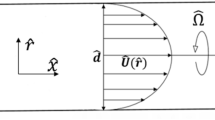Abstract
Without simplifying the N-S equations of Germano's[5], we study the flow in a helical circular pipe employing perturbation method. A third perturbation solution is fully presented. The first- second- and third-order effects of curvature κ and torsion τ on the secondary flow and axial velocity are discussed in detail. The first-order effect of curvature is to form two counter-rotating cells of the secondary flow and to push the maximum axial velocity to the outer bend. The two cells are pushed to the outer bend by the pure second-order effect of curvature. The combined higher-order (second-, third-) effects of curvature and torsion, are found to be an enlargement of the lower vortex of the secondary flow at expense of the upper one and a clockwise shift of the centers of the secondary vortices and the location of maximum axial velocity. When the axial pressure gradient is small enough or the torsion is sufficiently larger than the curvature, the location of the maximal axial velocity is near the inner bend.
The equation of the volume flux is obtained from integrating the perturbation solutions of axial velocity. From the equation the validity range of the perturbation solutions in this paper can be obtained and the conclusion that the three terms of torsion have no effect on the volume flux can easily be drawn. When the axial pressure gradient is less than 22.67, the volume flux in a helical pipe is larger than that in a straight pipe.
Similar content being viewed by others
References
Dean WR. Note on the motion of fluid in a curved pipe.Phil Mag, 1927, 4(7): 208–223
Dean WR. The stream-line motion of fluid in a curved pipe.Phil Mag, 1928a, 5: 673–695
Berger SA, Talbot L, Yao LS. Flow in curved pipes.Ann Rev Fluid Mech, 1983, 15: 461–572
Wang CY. On the low-Reynolds-number flow in a helical pipe.J Fluid Mech, 1981, 108: 185–194
Germano M. On the effect of torsion on a helical pipe flow.J Fluid Mech, 1982, 125: 1–8
Chen WH, Jan R. The characteristics of laminar flow in a helical circular pipe.J Fluid Mech, 1992, 244: 241–256
Kao HC. Torsion effect on fully developed flow in a helical pipe.J Fluid Mech, 1987, 184: 335–356
Xie GD. Torsion effect on secondary flow in helical pipe.Int J Heat and Fluid Flow. 1990, 11(2): 114–119
Bolinder CJ. First- and higher-order effect of curvature and torsion on the flow in a helical rectangular duct.J Fluid Mech, 1996, 314: 113–138
Fan DN, Xu CG. Tensorial Fluid Mechanics. Spac, Graphic Inc. 1983
Van Dyke M. Extended stokes series: laminar flow through a loosely coiled pipe.J Fluid Mech, 1978, 86: 129–145
Author information
Authors and Affiliations
Rights and permissions
About this article
Cite this article
Jinsuo, Z., Benzhao, Z. Fluid flow in a helical pipe. Acta Mech Sinica 15, 299–312 (1999). https://doi.org/10.1007/BF02487928
Received:
Revised:
Issue Date:
DOI: https://doi.org/10.1007/BF02487928




